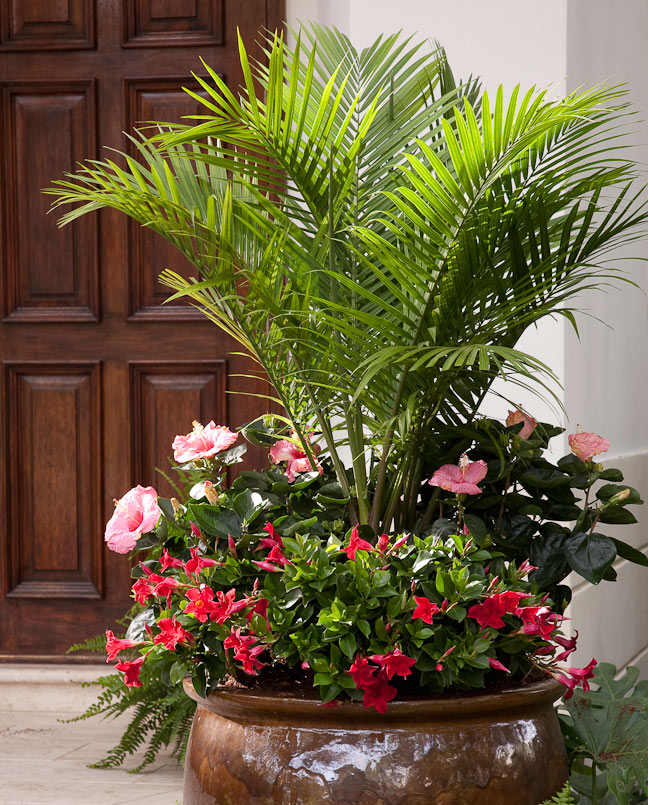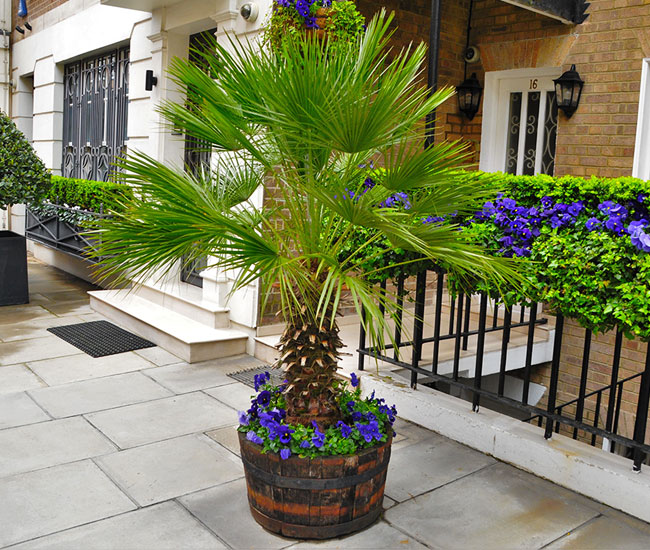
Making your landscaping stand out can be challenging. Fortunately, palm trees are distinctive in almost any yard. However, you don’t have to allow these kinds of trees grow haphazardly around your land. If you’re unsure, think about growing your favourite palm tree in a big pot.
The majority of palm trees are resistant and adaptable, which enables them to flourish in a variety of environments. You can move these trees about at your convenience without worrying about the potential effects of the roots on the structural integrity of your home, so long as you give them large enough pots.
Table of Contents
What Palms Can Be Grown In Pots Outdoors?
Not every palm tree will grow well in a pot. You can pick from any of the following if you’re looking for an excellent starting palm tree to put in a pot or other planter:
1. Chinese Fan Palm (Livistona chinensis)
Chinese fan palms, also referred to as fountain palms, are regarded as some of the best beginning palms for gardeners wishing to add a little flair to their front walks. You’re in luck if you reside in a region with compacted soil or irregular rainfall patterns. The Chinese fan palm is renowned for its toughness and can withstand both cold and drought without losing its energy.
When fully grown, the Chinese fan palm can reach a height of forty feet and a spread of twelve feet. The optimal conditions for these palms are full sunlight and slightly acidic soil. In hardiness zones 9 and 10, you’ll have the most success growing these palms to their full potential.
You can keep your container small for the first few years of the palm’s existence if you’re cultivating these kinds of palms in pots. But as it develops, be ready to move your Chinese fan palm to account for its root expansion.
2. Jelly Palm (Butia capitata)
Although jelly palms are wider than they are tall, they will still offer a dignified touch to your front walk despite their wider stature. Jelly palms have a tendency to weep downward, making them stand out and providing shade for your lawn at the same time.
Jelly palms are another tough palm tree that can withstand salt, heat, and drought without wilting. Even though it’s not in your best interest to cultivate these palms in colder climates, as long as the temperature maintains about 14 degrees Fahrenheit, you can watch a potted jelly palm flourish.
Jelly palms grow to a maximum height and width of twenty feet and fifteen feet, respectively, as adults. These palms thrive in soil with good drainage and in direct sunlight. Make sure the pot you have available for your jelly palm can accommodate its inherent stoutness as well as its vast root development.
3. Silver Saw Palmetto (Serenoa repens)
Silver saw palmetto palms, which are primarily found in Florida and comparable areas, have a better chance of surviving in milder climates than most other palms. You can rely on these palms to not only survive through some of the colder months of the year but also to offer a spiky pop to your landscaping plans. They are another another particularly durable palm tree.
Silver palms typically grow broader rather than taller. These palms often spread twenty feet wide and reach a maximum height of eight feet. As previously noted, these palms can withstand harsh environments. They can tolerate salt and deer in addition to being resistant to the cold. These palms don’t actually tolerate drought, but they also don’t need a lot of water to survive. You may grow these palms in any hardiness zone between 7 and 10, provided you buy a broad container.
4. Mexican Blue Palm (Brahea armata)
Concerned about the potential effects of the summer’s heat on the wellbeing of your potted palm? Mexican blue palms are among the most heat-resistant palms available. Even in the hottest summers, these palms’ stunning silver fronds may fan out across your yard.
Zones 9 to 11 of the USDA Plant Hardiness Scale are ideal for growing Mexican blue palms. They do best in sandy and loamy soils, although they can also do well in pots with good drainage. When properly cared for, these palms may reach a maximum height of forty feet, making them some of the taller potted palms you can have around your house.
However, Mexican blue palms are quite uncommon. You should ask the experts at your neighborhood nursery for advice if you want to add one to your landscaping.
5. Adonidia (Veitchia merrillii)
Adonidia palms, also referred to as Christmas palms, are on the smaller side when it comes to potted palms. Nevertheless, these decorative additions to your front lawn will draw the attention of just about any onlooker.
Hardiness zones 10 or higher, with temperatures that don’t fall below 32 degrees Fahrenheit, appear to be the ideal zones for adonidia palm growth. Compared to their cousins, these palms typically grow more slowly and rarely reach heights of more than fifteen feet. The good news is that a Christmas palm requires not as much upkeep as many other potted palms. In this video, you can observe how self-cleaning most adonidia palms are:
6. Bismark Palm (Bismarckia nobilis)
Every palm listed here can be grown successfully in pots. However, you should approach your initial buying for the bismark palm anticipating some major growth. Among the palms that could be potted, bismark palms are among the tallest. When taken care of properly, these palms can grow to a height of 60 feet. Their spreads alone have a maximum length of sixteen feet.
The best hardiness zones for Bismark palms are 10 and 11. These trees are somewhat more susceptible to lower temperatures than many of its relatives; exposure to freezing weather can significantly impede their growth. However, bismarks prefer full sun exposure and do best when planted in soil that drains well. Just be ready for it to become the center of attention not only around your home but up and down the entire block once you add a bismark to your front lawn.
7. Lipstick Palm (Cyrtostachys renda)
Want to give your garden a splash of color? Lipstick palms are distinct from other species due to their thin stature and vividly red trunk coloring.
However, compared to other palms that do well in pots, these ones can be a little more fickle. You need to reside above USDA Plant Hardiness Zone 10 in order to observe a lipstick palm properly establish itself near your home. In a similar vein, you should avoid exposing your lipstick palm to temperatures below 40 degrees Fahrenheit in order to prevent slowing its growth.
When taken care of properly, lipstick palm trees can reach heights of up to fifty feet when placed in the ideal environment. The majority of the time, though, these palms will stop growing after they reach a height of thirty feet, which makes them a fantastic focal point for any front yard.
8. Chesnut Dioon (Dioon edule)
Compared to other palms, chesnut dioon palms often develop more slowly. At just eight feet in height, they are also among the shortest of the potted palms. Having said that, the Chesnut dioon will give your garden an unusual look. For instance, Chesnut dioon palms all produce seeds, but the size and shape of those seeds varies depending on the gender of the tree.
However, in general, these palms are a great choice for new gardeners wishing to gain more potting expertise as a starting palm. Chesnut dioon palms can resist even the heaviest summers since they can tolerate salt and drought well.
How Can You Grow Potted Palms?

Developing potted palms can require some practice. The good news is that most potted palms often require little upkeep. Nevertheless, you cannot simply plant these palms wherever. If you do your homework in advance, you’ll know what kind of soil, light, water, and fertilizer your preferred palm need to develop to its greatest potential.
What Soil Do Potted Palms Need?
In USDA Plant Hardiness Zones 9 through 11, Mexican blue palms thrive the best. Although they perform best in sandy and loamy soils, they can also be successfully planted in pots with good drainage. These palms are some of the taller potted palms you can have around your house; given proper care, they can reach a maximum height of forty feet.
What Light and Shade Do Potted Palms Need?
Mexican blue palms are very uncommon, nevertheless. If you want to include one in your landscaping, you should ask the experts at your neighborhood nursery for advice.
The adonidia palm, also referred to as a Christmas palm, is one of the more diminutive potted palms. Nevertheless, any onlooker will be drawn to these decorative additions to your front lawn.
What Amount of Water Do Potted Palms Need?
Hardiness zones 10 or higher and temperatures that don’t go below 32 degrees Fahrenheit are typically the greatest places for adonidia palms to thrive. These palms often reach a maximum height of fifteen feet but generally develop more slowly than their cousins. A Christmas palm is generally minimal maintenance, like many other potted palms. According to this video, the majority of adonidia palms also self-clean:
When Should You Transplant A Potted Palm?
The palms mentioned here can all be planted successfully in pots. You should be ready for some major growth when you do your initial shopping for the bismark palm, though. One of the tallest types of palms that could be potted is the bismark palm. When properly maintained, these palms can grow up to 60 feet tall. The length of their spreads by itself can reach sixteen feet.
Zones 10 and 11 are the ideal growing range for Bismark palms. The growth of these trees can be severely stunted by exposure to freezing weather since they are a little more susceptible to cooler temperatures than many of their relatives. Although bismarks prefer full sun exposure and do best when planted in well-draining soil, they are similar to most palms in that regard. Just be ready for a bismark to become the center of attention not just close to your home but all the way down the block once you add one to your front lawn.
